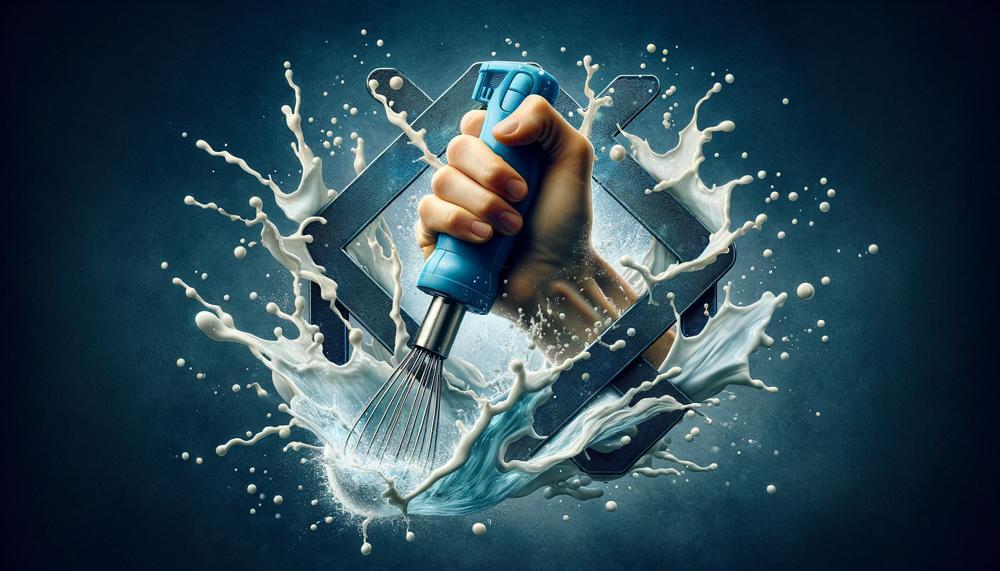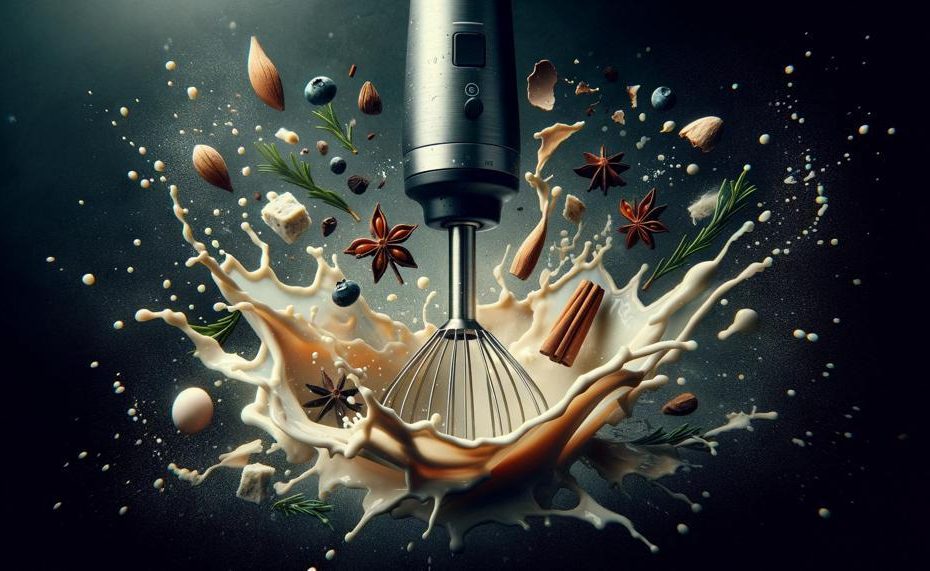Do you dread pulling out your hand blender because of the inevitable splashes that come with it? You’re not alone. Many home cooks and chefs have experienced the frustration of trying to blend soups, sauces, or smoothies without creating a mess. But don’t give up on your trusty kitchen tool just yet. With a few expert tips and tricks, you can conquer those splashes and blend like a pro.
So put away your apron and listen closely, because we’re about to reveal the secrets to preventing splatters while using a hand blender. Here’s what you need to know:
- Choose the right container: Opt for a tall and narrow container to keep your ingredients contained within the blending area and minimize splashes.
- Start slow: Beginning with a low speed will reduce the chances of creating messy splatters as the blades won’t be spinning too quickly.
- Keep it submerged: Before turning on the blender, make sure its blades are fully submerged in the ingredients to avoid any air pockets that can cause unwanted splashes.
By following these simple yet effective techniques, you’ll be able to blend like a pro without any mess or stress.
Say goodbye to frustrating splashes and hello to smooth and delicious results.
Contents
Big Container
When it comes to using a hand blender, the size of the container is crucial in preventing splashing. To avoid spillage, a bigger bowl is recommended as it allows enough space for the ingredients to move around without splashing outside. It is best to use a bowl that is at least double the volume of the ingredients being blended.
There are various factors to consider when selecting the right size container for blending with a hand blender. These include the type of ingredients used, the speed and power of the blender, and personal preferences. While a larger bowl may not be necessary for blending small amounts of liquids, it can be beneficial when working with thicker or larger quantities of ingredients.
In addition to using the appropriate container size, proper technique is also crucial in minimizing splashing. Keeping the blade submerged in the liquid at all times and avoiding sudden movements while blending can greatly reduce the chances of splashing. Tipping the bowl and starting the blender before inserting it can also help balance out the blending process and prevent spills.
Hand Movement In a Proper Way
To avoid splashing while using a hand blender, it is crucial to employ controlled and intentional hand movements. Here are some recommended hand movements to follow:
- Angle the blender: Before powering on the hand blender, hold it at a slight angle towards the bottom of the bowl. This will create a more balanced blend and minimize splashing.
- Start blending before inserting: Always turn on the hand blender before inserting it into the bowl. This will prevent any initial splashing and allow for a smoother blend.
- Use small, circular motions: Instead of rapidly moving the blender up and down, use small, circular motions to blend the ingredients. This will keep the ingredients within the bowl and reduce splashing.
- Keep the tip of the blender in the ingredients: Only place the tip of the blender into the ingredients, rather than completely submerging it. This will prevent ingredients from splashing out of the bowl.
- Avoid sudden movements: While blending, avoid sudden or jerky movements with your hand. This can cause splashing and affect the consistency of your blend.
By following these proper hand movements, you can achieve a smooth and mess-free blending experience with your hand blender.
Focusing on Holding Angle
When utilizing a hand blender, minimizing splashing can be achieved by focusing on the holding angle, container size, and hand movement.
The best holding angle is between 45-60 degrees from the liquid surface, ensuring efficient blending without excess air incorporation that causes splashing.
Refer to the following table for key tips to prevent splashing while using a hand blender:
| Tip | Description |
| Use a sufficiently large container | Using a container that is large enough reduces splashing and improves blending efficiency. |
| Pay attention to hand movement | Maintain a safe distance from the blades and use small circular motions to prevent liquid from escaping. |
| Angle the blender | Tilting the blender at a 45-60 degree angle from the liquid surface can also prevent splashing. |
| Add dry ingredients first | Adding dry ingredients before liquids can absorb some of the liquid and reduce splashing. |
| Use crushed ice | Crushed ice can also absorb some of the liquid and minimize splashing. |
| Control the speed of the blender | Starting at high speed may cause splashing, so it is recommended to start at the lowest setting and gradually increase speed. |
| Use a snug lid | A tight-fitting lid on the container can also prevent splashing. |
By keeping these tips in mind, you can confidently use your hand blender without worrying about making a mess. Always consider the size of your container, hand movements and angle, and blender speed for a smooth blending experience.
Control On Blending Speed
Controlling the blending speed is a crucial element in preventing splashing when using a hand blender. By managing the speed, you can avoid creating a chaotic and messy situation, ensuring a seamless blending experience.
Here, we will delve into the intricacies of how adjusting the blending speed plays a vital role in preventing splashing and provide some valuable tips for achieving the perfect blend.
| Tip | Description | Benefit |
| Control On Blending Speed | Start at high speed and decrease gradually if necessary. | Prevents splashing and guarantees a smooth blending experience. |
| Be Mindful of Hand Movement | Maintain a fluid circular motion at least an inch away from the blades. | Helps prevent liquid from splashing out. |
| Use a Large Container | Allows enough room for ingredients to move without causing splashing. | Prevents mess and ensures efficient blending. |
| Tilt at an Angle | Incline the blender at 45-60 degrees while blending. | Prevents liquid from splashing out. |
| Add Dry Ingredients First | Add dry ingredients before liquid to absorb some of the liquid and prevent clumping. | Reduces splashing and guarantees smooth blending. |
| Use Crushed Ice | Incorporate crushed ice to thicken and cool the liquid, reducing splashing. | Assists in achieving desired consistency and prevents mess. |
| Use a Snug-Fit Lid | Utilize a lid that fits tightly on the blender to keep everything contained. | Prevents splashing and mess. |
| Start at High Speed | Begin blending at high speed instead of gradually increasing. | Reduces splashing and ensures efficient blending. |
| Add Ice or Use a Plastic Bowl | Including ice or using a plastic bowl can help reduce splashing. | Provides a barrier to prevent splashing and mess. |
By following these helpful tips and properly adjusting the blending speed, you can effectively prevent splashing and achieve a smooth and efficient blend. Always remember to pay attention to your hand movements, use a container that is large enough, and start at high speed for optimal results.
Prevent The Vortex Motion
There are numerous methods to avoid the vortex motion when using a hand blender to prevent splashing. It’s vital to remember that hand blenders, also known as immersion blenders, are powerful tools that can create a vortex motion if not used correctly. This can result in messy and frustrating blending experiences. Here are some techniques to prevent the vortex motion and minimize splashing while using a hand blender:
Begin blending at a lower speed and gradually increase to high speed: This will assist in preventing the sudden formation of a vortex, which can lead to splashing. Gradually increasing the speed will also result in a smoother blend.
Hold the stick blender at a 45-degree angle and use a circular motion: This method will help keep the ingredients moving in a circular motion instead of creating a vortex.
- Use a paper plate as a lid with a hole in the middle: Place the paper plate over the container you are using, with the hole over the stick blender. This will act as a shield and prevent any splashing.
- Avoid moving the blender in a vortex motion: Try to keep the blender in one spot without moving it around in a circular motion. This will minimize any splashing or mess.
- Use an immersion blender for both wet and dry ingredients without splashing: Immersion blenders are versatile and can easily blend both wet and dry ingredients without making a mess.
- Begin blending on low and work down vertically from the top of the container: This technique will help prevent any splashing as you gradually increase the speed and move down towards the bottom of the container.
- Cut food into smaller pieces before blending: By cutting food into smaller pieces, you can minimize splattering and ensure a smooth blend.
- Move the blender around in every direction while submerged: This will help evenly blend all ingredients and prevent a vortex motion from forming.
- Add oil slowly to prevent breaking and maintain a smooth consistency: When adding oil to a mixture, do it slowly and in a steady stream to avoid breaking the emulsion and creating a messy blend.
- Use an immersion blender with high wattage and multiple speed settings: A more powerful immersion blender will be able to blend more efficiently without creating a vortex motion.
- Choose a compact size and dishwasher safe parts when shopping for an immersion blender: Compact size blenders are easier to maneuver, and dishwasher safe parts make for easy cleanup.
- Fully submerge the blade at all times while blending: This will help prevent any splashing and ensure all ingredients are evenly blended.
- Start at a slow speed, gradually increasing as needed: Similar to the first tip, starting at a slower speed and gradually increasing will help prevent a sudden vortex motion.
Keep the blender in an ideal position close to the pot or bottom without touching it: By keeping the blender near the bottom of the container, you can prevent splashing and ensure all ingredients are evenly blended.
How Deep The Bowl Is
Choosing the perfect bowl depth for hand blender usage can be a tricky task. It’s typically suggested to have a bowl depth of 6-8 inches, as this allows enough room for the beaters to move around without creating a mess. However, the exact depth may vary based on the amount of ingredients being mixed and personal preference.
To guarantee efficient mixing and prevent splashing, it’s best to opt for a deep and wide-based bowl. This provides ample space for the beaters to move freely without causing excessive splashing. Additionally, selecting a bowl with a non-slip base can help keep the bowl steady during the mixing process.
When it comes to material, stainless steel, glass, and ceramic are top choices for mixing bowls when using a hand blender. These materials are strong and non-reactive to acidic ingredients. But it’s important to note that sudden temperature changes or drops can cause glass bowls to break.
Proper handling and cleaning methods are crucial when using mixing bowls for hand blenders. Avoid using metal utensils or harsh scrubbers on stainless steel bowls, as this can cause damage. It’s also important to thoroughly dry the bowl before using it again to prevent any potential issues.
Using Container Attachment
Utilizing a container attachment is an effective approach to avoid splashing while blending as it provides a snug fit over the top of the blender, keeping all ingredients contained inside.
The following table highlights the key benefits and features of using a container attachment when utilizing a hand blender:
| Advantages | Characteristics |
| Prevents splashing | Tightly fits over the top of the blender |
| Allows for a smoother and more controlled blending process | Ensures all ingredients are contained inside |
| Reduces mess and clean-up time | Fits tightly on the blender |
By incorporating a container attachment into your blending process, you can easily manage and control the blending without any concerns about splashing. This is particularly helpful when blending thick or chunky ingredients that may cause splashing without proper containment.

Furthermore, starting at high speed and gradually increasing the speed can also lead to splashing, so using a container attachment can effectively prevent this issue.
Conclusion
In conclusion, mastering the art of using a hand blender without splashing is all about technique and tools.
With a tall and narrow container, starting at a low speed, and keeping the blades submerged in the ingredients, you can blend like a pro without any messy splashes. But that’s not all – proper hand movements, holding angle, container size, and controlling the blending speed are also crucial in achieving splash-free results.
So don’t let the fear of splashing hinder your blending skills. With these expert tips and tricks up your sleeve, you’ll be able to create smooth and delicious recipes with ease.





